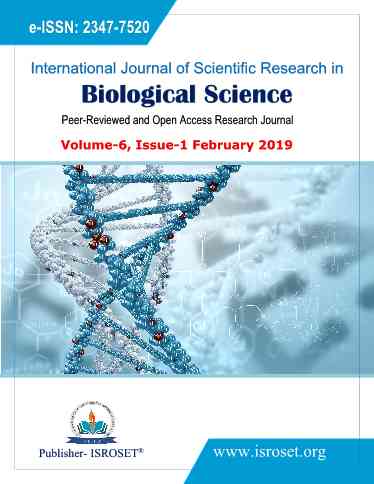Abnormalities in Lipid Profile Amongst Type 1 and Type 2 Diabetes in North Indian Population
Keywords:
Diabetes, Lipid Profile, Cholesterol, VLDL, LDL, HDL, triglyceridesAbstract
Diabetes mellitus is characterized by hyperglycemia resulting from defects in insulin secretion, insulin action, or both. Lipid abnormalities which can occur in diabetes mellitus can further complicate management of patients and is believed to play an important role in the pathogenesis of atherosclerosis. Keeping the above in view the present study aims to look for association between the lipid profile amongst diabetic patients and normal healthy controls in the Punjabi population. To meet the above objective blood samples were collected from a total of 100 diabetic subjects (20 type 1 and 80 type 2 diabetes) visiting the OPD and ward of department of medicine, in Civil Hospitals of Kapurthala, Jalandhar and Amritsar and 100 normal healthy controls matched for age and sex. Each patient was investigated for plasma glucose fasting (FPG), glycosylated hemoglobin (HbA1c), serum cholesterol (TC), serum triglyceride (TG), high density lipoproteins (HDL) low density lipoproteins (LDL) and very low density lipoproteins (VLDL). The mean serum cholesterol, triglycerides, LDL cholesterol, VLDL cholesterol and HDL cholesterol in diabetic subjects were 191.27 + 30.85 mg/dl, 159.11+ 37.11 mg/dl, 115.80 + 25.62 mg/dl, 31.48 + 7.68 mg/dl and 43.22 + 5.00 mg/dl while their levels in normal healthy individuals were 166.21 + 9.67 mg/dl, 123.69 + 15.87 mg/dl, 96.57 + 7.97 mg/dl, 24.78 + 3.15 mg/dl and 44.90 + 1.49 mg/dl respectively. The mean serum cholesterol, triglycerides, LDL cholesterol and VLDL cholesterol was significantly higher while serum HDL value was significantly lower in diabetic subjects as compared to non diabetic subjects. This study shows dyslipidemia among diabetic patients and proposes that the failure to recognize the presence of abnormal lipid profile may be a primary cause of poor management often encountered in some of the treated diabetics.
References
American Diabetes Association, “Diagnosis and classification of diabetes mellitus”, Diabetes Care, Vol.33, No.1, pp.62-69, 2010.
National Cholesterol Education Program, “Executive summary of the third report of the National Cholesterol Education Program (NCEP) Expert Panel on Detection, Evalution and Treatment of High Blood Cholesterol in Adults (Adult Treatment Panel lll)”, JAMA, Vol.285, No.19, pp.2486-2497, 2001.
T.J. Chahil, H.N. Ginsberg, “Diabetic dyslipidemia”, Endocrinol Metab Clin North Am, Vol.35, No.3, pp.491-510, 2006.
I.J. Goldberg, “Diabetic dyslipidemia: Causes and consequences Clinical Review”, J Clin Endocrinol Metab, Vol. 86, No.3, pp.965-971, 2001.
A Ozder, “Lipid profile abnormalities seen in T2DM patients in primary healthcare in Turkey a cross-sectional study”, Lipids Health Dis, Vol.13, pp.183-188, 2014.
UK Prospective Diabetes Study 27, “Plasma lipids and lipoprotein at diagnosis of NIDDM by age and sex”, Diabetes Care, Vol.20, No.11, pp.1683-1687, 1997.
A. Fontbonne, E. Eschewge, F. Cambien, J.L. Richard, P. Ducimetiere, N.Thibuld, J.M. Warnet, J.R.Claude, G.E. Rosselin, “Hypertriglyceridemia as a risk factor for coronary heart disease motality in subjects with impaired year follow up of the Paris Prospective study”, Diabetologia, Vol. 32, No.5, pp.300-304, 1989.
V. Chaturvedi, B. Bhargava, “Health Care Delivery for Coronary Heart Disease in India-Where are we headed”, Am Heart Hosp J, Vol. 5, No.1, pp.32-37, 2007.
E.A. Enas, V. Chacko, S.G. Pazhoor, H. Chennikkara, P. Devarpalli P, “Dyslipidemais in South Asian Patients”, Current Atherosclerosis Reports, Vol.9, No.5, pp.367-374, 2007.
P. Pasupathi, P. Manivannam, M. Uma, M. Deepa, “Glycated hemoglobin (HbA1C) as a stable indicator of type 2 diabetes”, Int J pharm Biomed Res, Vol.1, No.2, pp.53-56, 2010.
S. Smith, A.M. Lall, “A Study on Lipid Profile levels of Diabetic and Non Diabetics Among Naini Region of Alhabad, India” , Turk J Biochem,Vol.33, No. 4, pp.138-141, 2008.
K.N. Frayn, “Adipose tissue and the insulin resistance syndrome”, Proc Nutr Soc, Vol. 60, No.3, pp.375-380, 2001.
M. Adiels, J. Westerbacka, A. Soro-Paavonen, A.M. Häkkinen, S. Vehkavaara, M.J. Caslake, C. Packard, S.O. Olofsson, H. Yki-Järvinen, M.R. Taskinen, J. Boren, “Acute suppression of VLDL(1) secretion rate by insulin is associated with hepatic fat content and insulin resistance”, Diabetologia, Vol. 50, No.11, pp.2356-2365, 2007.
A.D. Mooradian, M.J. Hass, S.G. Albert SG, “Low serum high-density lipoprotein cholesterol in obsess subjects with normal serum triglycerides: the role of insulin resistance and inflammatory cytokine”, Diabetes Obes Metab, Vol.9, No.3, pp.441-443, 2007.
A.D. Mooradian, M.J. Hass, C.W.W Norman, “Transcriptional control of apolipoprotein A-l gene expression in diabetes mellitus”, Diabetes, Vol.53, No.3, pp.513-520, 2004.
J.A. Kayode, A.O. Sola, A.S. Matthew, B.O. Adesola, I. Ademola, A.T. Adedeji, A.S. Adelani, “Lipid profile of type 2 diabetic patients at a rural tertiary hospital in Nigeria”, J Diabetes Endicronol, Vol.1, No.4, pp.46-51, 2010.
L.M. AI-Naama, M. Kadhima, M.S. AI-Aboud, “Lipid profile in children with insulin dependent diabetes mellitus”, J Pak Med Assoc, Vol.52, No.1, pp.29-34, 2002.
B. Salzer, A. Stavljenic, G. Jurgens, M. Dumic, A. Radica, “Polymorphism of apolipoprotein E, lipoprotein (a) and other lipoprotein in children with type 1 diabetes” , Clin Chem, Vol.39, No.7, pp.1427-1432, 1993.
L. Gordon, D. Ragoobirsingh, E.Y.A Marrison, E. Choo-Kang, D. McGrowder, E. Martorell, “Lipid profile of type 2 diabetic and hypertensive patients in the Jamaican population”, J Lab physicians, Vol.2, No.1, pp.25-30, 2010.
B. Seyoum, J. Abdul kadir, P. Berhanu, Y. Felekey, Z. Mengistu, G. Ayana, “Analysis of serum lipids and lipoproteins in Ethiopian diabetic patients”, Ethiop med J, Vol.41, No.1, pp.1-8, 2003.
Downloads
Published
How to Cite
Issue
Section
License

This work is licensed under a Creative Commons Attribution 4.0 International License.
Authors contributing to this journal agree to publish their articles under the Creative Commons Attribution 4.0 International License, allowing third parties to share their work (copy, distribute, transmit) and to adapt it, under the condition that the authors are given credit and that in the event of reuse or distribution, the terms of this license are made clear.







